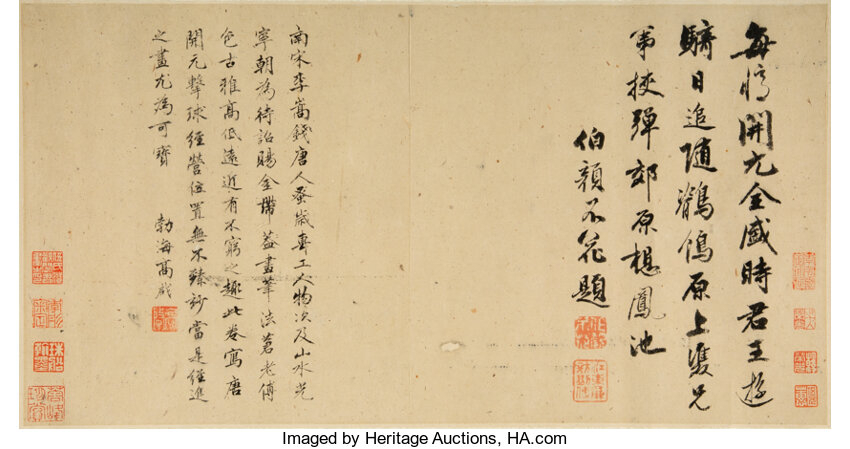
How an Ancient Chinese Handscroll Set a New Auction Record

A 14th-Century Chinese Calligraphy Scroll Breaks Records at Auction: The Story Behind a $32 Million Masterpiece
In what has become a landmark event in the world of fine art auctions, a handscroll created over 700 years ago by Chinese calligrapher Rao Jie soared to unprecedented heights, fetching more than $32 million at a Sotheby’s Hong Kong sale of Classical Chinese Paintings. The bidding, which lasted an extraordinary 95 minutes and attracted over 200 offers, smashed its pre-sale estimate of just $1.29 million (HKD 20,000,000) and has become the most valuable piece of Chinese calligraphy ever sold by the auction house.
But what drove the skyrocketing interest in this ancient artwork? The answer lies in a rich confluence of artistry, historical prestige, imperial legacy, and a renewed cultural nostalgia among collectors.
The Artist: Rao Jie and His Calligraphic Legacy
Rao Jie, a calligrapher from China’s Jiangxi province, lived during the transitional period between the Yuan (1271–1368) and Ming (1368–1644) dynasties. Melding styles drawn from historical masters and avant-garde traditions of his time, Rao’s work is emblematic of both classical reverence and expressive freedom.
His style synthesizes attributes from the revered “Two Wangs” — Wang Xizhi and Wang Xianzhi, fourth-century legends known for their graceful, flowing brushwork — and the spirited “Wild Cursive” tradition of the Tang dynasty. According to Yan Weitian, an assistant professor and historical calligraphy scholar from Indiana University, Rao’s work shines for its “fluent, spontaneous, and highly gestural movements,” a dynamic feat that continues to resonate with modern audiences.
A Tapestry of Words: Literary and Imperial Lineage
The scroll itself is not merely a visual delight — it also encapsulates some of the most respected literature of the Tang dynasty. The contents feature Rao Jie’s transcriptions of two foundational essays: Song Meng Dongye Xu (Preface on Seeing Off Meng Jiao) by Han Yu and Zi Ren Zhuan (Biography of a Carpenter) by Liu Zongyuan. Reproducing esteemed literary works is a time-honored tradition among Chinese calligraphers, often interpreted as a respectful homage and a vehicle for conveying one’s artistic voice.
However, what sets this handscroll apart is the accumulation of more than 100 postscripts, also known as colophons. These personal notes, added by admirers and later owners, are a testimony to the work’s continued appreciation and serve as both artistic critique and evidence of provenance.
Imperial Provenance: A Journey through Dynasties
What further propelled the scroll’s value was its illustrious ownership history. The piece once belonged to the Ming and Qing dynasties’ imperial collections. One of its most influential owners was Qianlong Emperor (1711–1799), the fourth emperor of the Qing dynasty, who was not only a prolific art collector but also a practitioner of painting and calligraphy himself.
Qianlong’s involvement elevated the scroll’s prestige. He added a frontispiece, meticulous documentation in his personal catalogue, and a postscript — an honor he reserved for only his most treasured works. “These details jack up the appeal of the piece (and the price) in the eyes of buyers,” said Michele Matteini, an art historian specializing in late imperial China.
Beyond Qianlong, the scroll passed through the collection of Prince Gong, a 19th-century Qing nobleman known for his refined tastes, before vanishing from public view in a private Japanese collection for over a century.
Modern Momentum: A Revival of Cultural Heritage
The scroll’s reemergence and record-breaking sale are part of a broader trend in the art world that recognizes the cultural gravity of Chinese imperial art. Sotheby’s Asia head Steven Zuo revealed that the April auction drew in a rising demographic of young collectors hungry for pieces that connect them with their heritage. In fact, 32% of bidders across Sotheby’s Asia last year were 40 and under — a figure that has doubled specifically in the realm of Classical Chinese Paintings this season.
This renewed enthusiasm comes in the wake of an equally successful October auction, which generated $11.47 million from the sale of 113 imperial paintings and calligraphy works, once again surpassing forecasts.
“There’s a peculiar nostalgia for court life fueling the imagination of buyers these days,” Matteini noted. As globalization intertwines with rising nationalism and cultural reflection, collectors are increasingly attracted to objects that tie them to a sense of identity, legacy, and cultural continuity.
Conclusion: More Than an Artifact
The $32 million handscroll by Rao Jie is not just an artwork — it is a vessel of time, bridging centuries of political change, artistic innovation, and reverential admiration. From the inked brushstrokes of